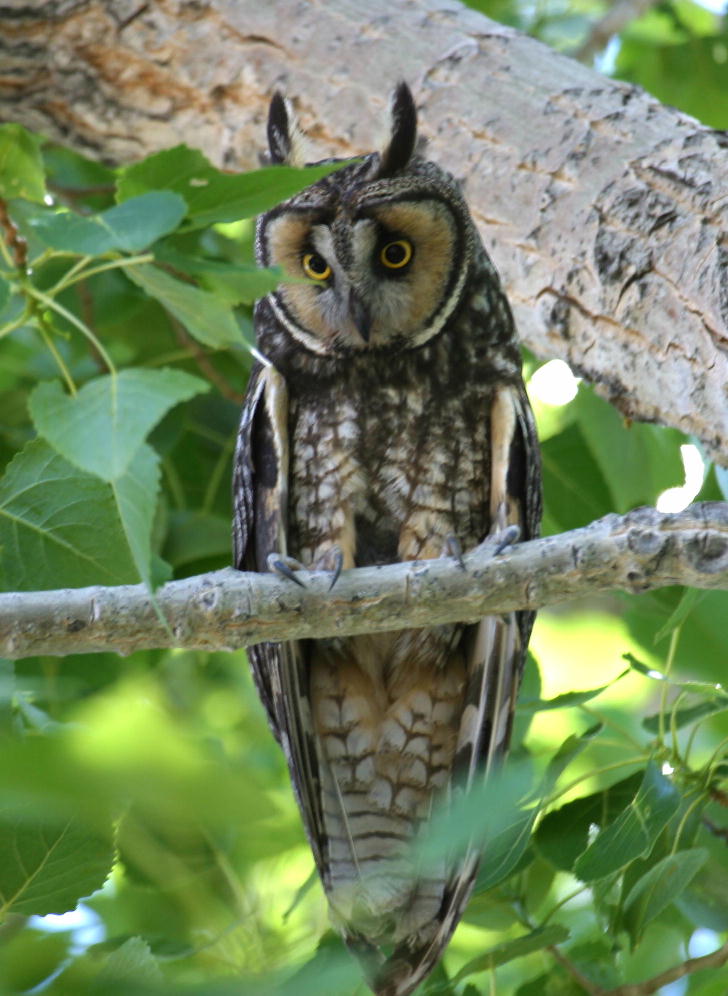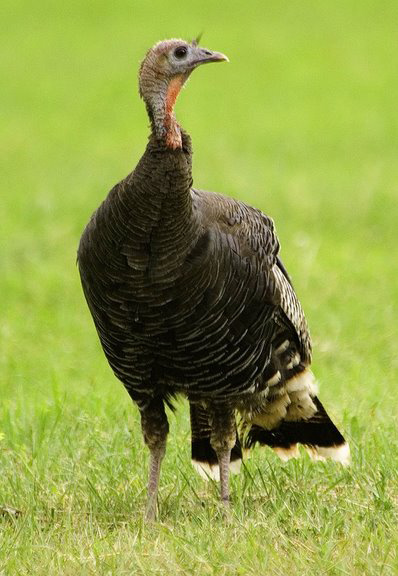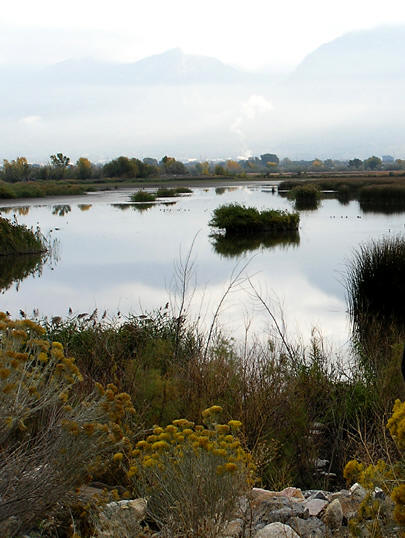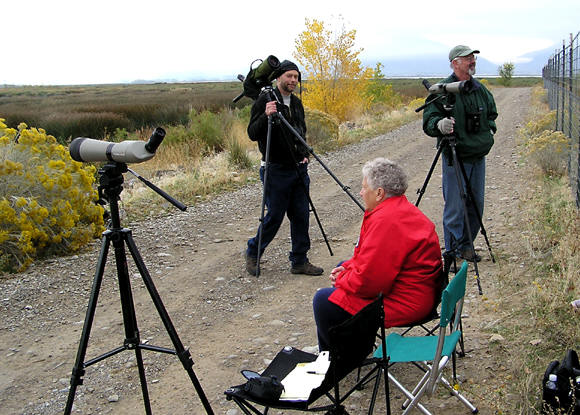Utah County Birders Newsletter
|
 |
|
photo by Jack Binch |
A Unique Experience
I have been watching birds for more than fifty years; spishing (or pishing) them
up for probably half that amount of time. As you can imagine I have had a lot of
interesting experiences, but nothing like what happened two days ago. I am
writing this on October 13, while it is still fairly fresh in my memory.
Because UVSC was out of school for Harvest Days Vacation, and since the school
where I teach is on the same schedule, I decided to see how many birds I could
find during that particular day. As I have reflected back on those eleven hours
of birding I realized that I probably will never have the combination of events
that transpired ever occur again. Hence the reason for writing them down.
I saw some good birds. Found a beautiful, male Townsend's Warbler at the
southwest corner of the Provo Airport Dike. Observed a small flock of about
30-35 Pine Siskins on the Skipper Bay Trail. At the end of the day I saw a
Prairie Falcon at LeBaron Point which is situated down at the south end of Utah
Lake. Sandwiched in between, Glen Barlow and I found three Common Grackles at a
feed lot in Lake Shore. Glen and I had linked up at River Lane, but we had only
birded together for about twenty minutes before he had to return home.
I had started out the morning by finding a Red-necked Grebe on Clegg's Pond in
west Orem, a fairly rare bird, but it was only a new bird for the year for
me--not even new for the county.
The most memorable event of all these I have mentioned occurred at the end of
the Skipper Bay Trail which I have already mentioned. As most of you who have
hiked it know, the paved part of the trail ends at a small stream which flows
into Utah Lake. On the other side of the stream there are a lot of bulrushes and
other thick emergent wetland vegetation. This is where I had found a Swamp
Sparrow the year before, and even though it was probably too early in the fall
to expect it again I thought I would try pishing to see what I could bring out,
possibly even a Lincoln's Sparrow. So I stepped down to the edge of the stream
to where I was partially surrounded by waist-high vegetation and started pishing.
About five to seven seconds had elapsed when I was startled by something landing
lightly on top of my head. 'That was a quick response,' I thought. It felt
heavier than a song bird, but not as heavy as what I thought a raptor might
weigh. At first I thought it might be a Magpie, but they had never responded to
my pishing before, so I eliminated that possibility. Instinctively I turned my
head. This action caused the bird to fly off me. I turned in time to see what it
was and caught a glimpse of a fair-sized brown bird just landing in a nearby
tree about thirty feet away. Its back was to me. Then it turned its head and
looked back a me. Quickly I trained my binoculars on it. Staring at me with two,
bright yellow eyes from golden-brown facial disks was a Long-eared Owl! I don't
know who was more surprised--the owl (realizing that I wasn't a prey item), or
me (realizing that it had been an owl on my head). Lucky for me I was wearing a
baseball cap, or I would have had talon marks in my bald scalp. Pete Dunne, who
wrote a book, The Art of Pishing, would have been proud.
 |
|
photo by Lu Giddings |
Bird of the
Month
Wild Turkey
Meleagris gallopavo
by Robin Tuck
It must have been 10 years ago, when one of my Church friends showed me a
picture of what he said was a 40 pound Tom Turkey he had 'harvested' from the
Cedar City area. This dedicated hunter wanted to see if I, a dyed-in-the-wool
birder, would be shocked at the target of his hunting prowess.
As it turns out, all of the Wild Turkeys in Utah are here as the result of
successful re-introductions by the Utah Division of Wildlife Resources funded by
the hunting community, principally, the Utah Chapter of the National Wild Turkey
Federation. These re-introductions began with a failed attempt in 1925, which
was tried again successfully in 1952 and continues today. Currently, most of the
re-introductions come from Utah populations that are trapped and released in new
places where the Division believes they will prosper.
Utah has two subspecies of Wild Turkeys, Rio Grande (Meleagris gallopavo
intermedia) and Merriam's (Meleagris gallopavo merriami), that differ
slightly in habitat selection, mature weight and coloration, with the feather
tips lighter in the Merriam's. The Merriam's are concentrated in the southern
part of the state and live in more mountainous terrain with ponderosa pine along
with aspens, grassy meadows and oak brush. The Rio Grande turkeys are scattered
throughout the state and choose to live at lower elevations favoring cottonwood
river bottoms and riparian areas with oak brush.
Turkeys and other upland game birds have a high rate of reproduction, with Toms
often breeding with up to 10 Hens, each having 10 to 12 eggs in their nest.
Because of this, hunting is limited to Toms with the hunting season being from
mid April to the end of May.
Wild Turkeys have been very successful in Utah, with an estimated population of
18,000 to 20,000 birds with most being the Rio Grande sub-species. This
abundance of turkeys has caused the DWR to increase the number of Turkey
permits; the 2007 number of 2900 expected to be increased at least by 30% for
2008.
Unlike their domesticated cousins, Wild Turkeys can fly for a short distance and
roost in trees for the night. It was with astonishment that I watched Wild
Turkeys fly out of tall cottonwoods early one morning, wondering how they got up
there the evening before. Wild Turkeys are somewhat smaller than domesticated
turkeys, with their average weights for Toms being 18 to 21 pounds, and for Hens
being 8 to 11 pounds which accounts for their ability to fly at all.
Many birders I know began their love of birds from hunting them, then switching
from shooting to simply watching. I suppose that some of these same birders
still creep off in the early morning hours shotgun in hand looking for Wild
Turkeys and other upland game birds. Your opinion may vary, but I appreciate the
conservation efforts and dollars invested by our hunting friends.
Field Trip Report
The Big Sit - 14th October 2007
Trip Report by Eric Huish
 |
|
The view from our Big Sit circle,
Provo Bay - 14 Oct 2007 |
 |
|
Big Sitters - Eric, Bonnie and Milt -
14 Oct
2007 |
A Big Sit is like a Big Day in that the object is to tally as many bird
species as can be seen or heard within 24 hours. The difference lies in the area
limitation (inside a 17-foot circle) from which you can observe. We sat
out on the Provo Airport Dike, on the East leg of the South extension.
This was our 6th annual Big Sit. We had a record number of participants this
year (14), a record amount of time spent at the circle (12 hours) and we had a record
number of species seen.
We ended the day with a total of 58 species. 3 more than our previous record.
There were two probables we weren't confident enough to count, several species
seen during the week leading up to the sit that we couldn't find on the day of,
and a few misses including Ring-necked Pheasant which we have never missed on a
big sit. 60 species is definitely possible and will be our goal next year.
I arrived at our sit circle at 6:30 a.m. and was immediately greeted with a
Barn Owl that was hunting in the area (at one point only 15 feet away).
Milt Moody, Bonnie Williams and Tuula Rose showed up early (before light) and we
quickly started adding species. Virginia Rail, Song Sparrows, Marsh Wrens,
and Red-winged Blackbirds were calling and as soon as it was light enough to see
shapes on the mud-flat we picked out Black-crowned Night-herons and Great Blue
Herons. Larry Draper, Josh Heward and Yvonne Carter each joined us for a
while during the morning.
Most interesting sightings during the morning shift included hundreds of
Long-billed Dowitchers that spent the day on the mudflat, a Sora and Virginia
Rail out where we could see them along the front of the marsh, a Merlin that hung out in the trees at
the other end of the mudflat much of the morning, 3 Steller's Jays in some small
trees way out in the middle of the marsh (far from their normal habitat), two or
three Semipalmated Plovers way out on the far end of the mudflat and we had a
good movement of raptors in the early afternoon with at least 15 Red-tailed
Hawks making their way south. Ned Bixler showed up before noon, and after
Tuula, Milt and I left at 1:00 p.m., Ned took a lone watch to 4:00 p.m. He added
Turkey Vulture and Caspian Tern to our list.
Matt Mills and Stephanie and I arrived for the evening shift around 5:40 p.m. to
find Bonnie Williams already there along with a mess of mosquitoes that were not
there for the morning shift. Luckily Tuula showed up around 6:00 with some
bug spray. Matt spotted a couple of Golden Eagles in the distance and Tuula pointed
out a Cormorant flying over. We also had a couple of Cattle Egret and Caspian
Terns fly over. Paulette and her son stopped by for a few minutes to see
how we were doing and as it was getting dark, Jon Watkins and his 8 year-old son
Kendall joined us. Kendall is a very skilled birder. We had a large
flock of Sandhill Cranes (about 200) fly into the marshes across the bay at dusk
(we also had 3 soaring with the raptors in the early afternoon) and after dark
the Barn Owl made another appearance. Through the scope we watched
a Raccoon and Black-crowned Night-Heron feeding near each other on the mud-flat
for the last sighting of the day.
Spending a full day watching nature from one spot is fascinating to me. A
day has a flow to it. Owls before dawn and after dusk. The herons were
out on the mudflat only during the dark hours of the day. Birds were
singing in the morning hours. The Dowitchers came in from somewhere at dawn,
left for the afternoon, came back in the evening then left again at dusk.
Around mid-day Raptors were everywhere and gulls came in to roost on the
mudflat.
Thanks to all who participated. I hope to see you next year - Oct 12, 2008.
Species List - Canada Goose, Mallard, Northern Shovler, Green-winged Teal,
Western Grebe, Double-crested Cormorant, Great Blue Heron, Cattle Egret,
Black-crowned Night-Heron, White-faced Ibis, Turkey Vulture, Northern Harrier,
Sharp-shinned Hawk, Red-tailed Hawk, Golden Eagle, American Kestrel, Merlin,
Virginia Rail, Sora, American Coot, Sandhill Crane, Semipalmated Plover,
Killdeer, American Avocet, Greater Yellowlegs, Lesser Yellowlegs, Long-billed
Dowitcher, Wilson's Snipe, Ring-billed Gull, California Gull, Caspian Tern, Rock
Pigeon, Mourning Dove, Barn Owl, Northern Flicker, Steller's Jay, Black-billed
Magpie, American Crow, Northern Rough-winged Swallow, Barn Swallow, Black-capped
Chickadee, Marsh Wren, Ruby-crowned Kinglet, American Robin, European Starling,
American Pipit, Yellow-rumped Warbler, Spotted Towhee, Chipping Sparrow, Song
Sparrow, White-crowned Sparrow, Dark-eyed Junco, Red-winged Blackbird, Western
Meadowlark, Yellow-headed Blackbird, House Finch, Pine Siskin, American
Goldfinch.
Field Trip Report
Moab - 26-27th October 2007
Trip Report by Lu Giddings
I made the drive to Moab Friday morning and spent the rest of the day and yesterday morning birding around town and the adjacent area. Moab is as beautiful as ever, especially with the cottonwoods wearing their autumn colors, and the weather was absolutely perfect. The nearly full moon added to the glory of the surroundings.
It was not my luck to see any unusual migrants. The birds seemed mostly to be of the "common permanent" or "common winter" variety. I think Iwas about two to three weeks and a storm or two too late for migrants, although who can say what I may have missed in such a brief trip?
It's really dry in and around town. Ken's Lake is about 30 feet lower than it's spring level. The Matheson Wetland Reserve seems to have roughly the same amount of water as the solid stone beneath Delicate Arch. And the river itself seems low, although I cannot say that it is any lower than one might expect this time of year. I didn't see any waders or any shore birds on this trip. Waterfowl numbers seemed lower than what one might reasonably expect. Even as I drove along the Colorado river from Moab to Cisco, the river and its banks seemed completely devoid of avian life - no great blue herons, no Canada geese, no common mergansers, only a small flock of ruddy ducks frolicking in a pool above Dewey bridge. Surprisingly, this is the second consecutive week I have struck out on mallards. Have they recently become an endangered specie?
The only noteworthy sightings were Eurasian Collared-Doves. Flocks of 5,6, and 16 were spotted around town early Saturday morning.
Total Count: 44 species - Gadwall, Northern Shoveler, Northern Pintail, Redhead, Lesser Scaup,
Bufflehead, Ruddy Duck, Eared Grebe, Western Grebe, Northern Harrier,
Sharp-shinned Hawk, Red-tailed Hawk, Golden Eagle, American Kestrel, Peregrine
Falcon, American Coot, Rock Pigeon, Eurasian Collared-Dove, Hairy Woodpecker,
Northern Flicker, Steller's Jay, Western Scrub-Jay, Black-billed Magpie,
American Crow, Common Raven, Horned Lark, Black-capped Chickadee, Ruby-crowned
Kinglet, Western Bluebird, Mountain Bluebird, Townsend's Solitaire, American
Robin, European Starling, American Pipit, Yellow-rumped Warbler, Spotted Towhee,
Song Sparrow, White-crowned Sparrow, Dark-eyed Junco, Red-winged Blackbird,
House Finch, Lesser Goldfinch, American Goldfinch, House Sparrow.
Backyard Bird of the
Month
October 2007
Fred Baker - Provo
I was glad to see the Oregon Juncos back, and the Finches showing
their beautiful yellow color.
Glenn Barlow - Fruit Heights
On Friday evening, October 12th, I saw both a Red-naped Sapsucker and a
Downy Woodpecker in the pine tree closest to my house. The Red-naped was
boring square holes in a bare spot in the tree. It rested awhile, then
disappeared!
Steve Carr - Holladay
Steller's Jay - First one in 37 years of observing in my backyard.
Lynn Garner - Provo
A Townsend's Solitaire piping in our tree.
Alona Huffaker - Springville
A couple of Steller's Jays have been around most of the month.
Eric Huish - Pleasant Grove
White-breasted Nuthatch - Yard lifer number 89.
Milt Moody - Provo
Steller's Jay - stopped for a drink at my bird bath.
LeIla Ogden - Orem
I did have a White Breasted Nuthatch show up at my feeders above Midway.
Lots of Chickadees and Junco's.
Cheryl Peterson - Provo
White-breasted Nuthatch (yard bird #56) and Steller's Jay (#57).
Bruce Robinson - West Jordan
Mountain Chickadee - A first for the yard!
Tuula Rose - Provo
The winter flocks have descended. Mountain chickadees, yellowrumps, kinglets,
waxwings and a new yard bird, a STELLER'S JAY!
Mark Stackhouse - Salt Lake City
Blackburnian Warbler - what a nice surprise on a rainy morning! - and -
Mountain Chickadee - my real favorite bird of the month, three of these
delightful gems have been coming daily all month, and one day one ate from my
hand while I was filling the feeders.
Alton Thygerson - Provo
Steller’s Jay - you could hear him/her before you saw it.
Merrill Webb - Orem
My yard was visited during the month of October by five Cassin's Finches
2-3 times.
Bonnie Williams - Mapleton
Steller's Jay - Quite a few lately. Sometimes several at a time. One of
my favorite birds.
We would like you to share your favorite backyard bird each
month. Please send your favorite bird at the end of the month to newsletter@utahbirds.org
or call 360-8777.